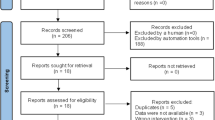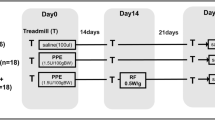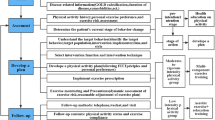Abstract
Study design:
Systematic review
Objectives:
To determine the effect of respiratory muscle training (RMT) on pulmonary function in tetraplegia.
Methods:
A comprehensive search of the research literature included MEDLINE, EMBASE, CINAHL, ISI Web of Science, PubMed, the relevant Cochrane and clinical trials registers and hand-searching the reference lists of appropriate papers. There was no language restriction. All randomised controlled trials that involved RMT vs control were considered for inclusion. Two reviewers independently selected articles for inclusion, evaluated the methodological quality and extracted data. Additional information was sought from the authors when necessary.
Results:
Eleven studies (212 participants) were included. A significant benefit of RMT was revealed for five outcomes: vital capacity (mean difference (95% confidence interval))=0.41(0.17–0.64) l, maximal inspiratory pressure=10.66(3.59, 17.72) cmH2O, maximal expiratory pressure=10.31(2.80–17.82) cmH2O, maximum voluntary ventilation=17.51(5.20, 29.81) l min−1 and inspiratory capacity=0.35(0.05, 0.65) l. No effect was found for total lung capacity, peak expiratory flow rate, functional residual capacity, residual volume, expiratory reserve volume or forced expiratory volume in 1 second.
Conclusion:
RMT increases respiratory strength, function and endurance during the period of training. Further research is needed to determine optimum dosages and duration of effect. This article is based in part on a Cochrane review published in the Cochrane Database of Systematic Reviews (CDSR) 2013, DOI:10.1002/14651858.CD008507.pub2. Cochrane reviews are regularly updated as new evidence emerges and in response to feedback, and the CDSR should be consulted for the most recent version of the review.
Similar content being viewed by others
Log in or create a free account to read this content
Gain free access to this article, as well as selected content from this journal and more on nature.com
or
References
DeVivo MJ . Epidemiology of traumatic spinal cord injury: trends and future implications. Spinal Cord 2012; 50: 365–372.
Postma K, Haisma JA, de Groot S, Hopman MT, Bergen MP, Stam HJ et al. Changes in pulmonary function during the early years after inpatient rehabilitation in persons with spinal cord injury: a prospective cohort study. Arch Phys Med Rehabil 2013; 94: 1540–1546.
Cardozo CP . Respiratory complications of spinal cord injury. J Spinal Cord Med 2007; 30: 307–308.
Brown R, DiMarco AF, Hoit JD, Garshick E . Respiratory dysfunction and management in spinal cord injury. Respir Care 2006; 51: 853–868 discussion 869–870.
Sapienza C, Troche M, Pitts T, Davenport P . Respiratory strength training: concept and intervention outcomes. Semin Speech Lang 2011; 32: 21–30.
Mueller G, Hopman MT, Perret C . Comparison of respiratory muscle training methods in individuals with motor and sensory complete tetraplegia: a randomized controlled trial. J Rehabil Med 2013; 45: 248–253.
Van Houtte S, Vanlandewijck Y, Kiekens C, Spengler CM, Gosselink R . Patients with acute spinal cord injury benefit from normocapnic hyperpnoea training. J Rehabil Med 2008; 40: 119–125.
Tamplin J, Baker FA, Grocke D, Brazzale DJ, Pretto JJ, Ruehland WR et al. Effect of singing on respiratory function, voice, and mood after quadriplegia: a randomized controlled trial. Arch Phys Med Rehabil 2013; 94: 426–434.
Brooks D, O'Brien K, Geddes EL, Crowe J, Reid WD . Is inspiratory muscle training effective for individuals with cervical spinal cord injury? A qualitative systematic review. Clinl Rehabil 2005; 19: 237–246.
Sheel AW, Reid WD, Townson AF, Ayas NT, Konnyu KJ . Effects of exercise training and inspiratory muscle training in spinal cord injury: a systematic review. J Spinal Cord Med 2008; 31: 500–508.
Van Houtte S, Vanlandewijck Y, Gosselink R . Respiratory muscle training in persons with spinal cord injury: A systematic review. Respir Med 2006; 100: 1886–1895.
Berlowitz DJ, Tamplin J . Respiratory muscle training for cervical spinal cord injury. Cochrane Database Syst Rev 2013; 7: CD008507.
Zupan A, SÏavrin R, Erjavec T, Kralj A, KarcÏnik T, SÏkorjanc T et al. Effects of respiratory muscle training and electrical stimulation of abdominal muscles on respiratory capabilities in tetraplegic patients. Spinal Cord 1997; 35: 540–545.
Derrickson J, Ciesla N, Simpson N, Imle PC . A comparison of two breathing exercise programs for patients with quadriplegia. Phys Ther 1992; 72: 763–769.
Litchke L, Lloyd L, Schmidt E, Russian C, Reardon R . Comparison of two concurrent respiratory resistance devices on pulmonary function and time trial performance of wheel chair athletes. Ther Recreation J 2010; 44: 51–62.
Roth EJ, Stenson KW, Powley S, Oken J, Primack S, Nussbaum SB et al. Expiratory muscle training in spinal cord injury: a randomized controlled trial. Arch Phys Med Rehabil 2010; 91: 857–861.
Gounden P . Progressive resistive loading on accessory expiratory muscles in tetraplegia. S Afr J Physiother 1990; 46: 4–12.
Liaw MY, Lin MC, Cheng PT, Wong MK, Tang FT . Resistive inspiratory muscle training: its effectiveness in patients with acute complete cervical cord injury. Arch Phys Med Rehabil 2000; 81: 752–756.
Litchke LG, Russian CJ, Lloyd LK, Schmidt EA, Price L, Walker JL . Effects of respiratory resistance training with a concurrent flow device on wheelchair athletes. J Spinal Cord Med 2008; 31: 65–71.
Loveridge B, Badour M, Dubo H . Ventilatory muscle endurance training in quadriplegia: effects on breathing pattern. Paraplegia 1989; 27: 329–339.
Estenne M, De Troyer A . Mechanism of the postural dependence of vital capacity in tetraplegic subjects. Am Rev Respir Dis 1987; 135: 367–371.
Berlly M, Shem K . Respiratory management during the first five days after spinal cord injury. J Spinal Cord Med 2007; 30: 309–318.
Berney SC, Gordon IR, Opdam HI, Denehy L . A classification and regression tree to assist clinical decision making in airway management for patients with cervical spinal cord injury. Spinal Cord 2011; 49: 244–250.
Postma K, Bussmann JB, Haisma JA, van der Woude LH, Bergen MP, Stam HJ . Predicting respiratory infection one year after inpatient rehabilitation with pulmonary function measured at discharge in persons with spinal cord injury. J Rehabil Med 2009; 41: 729–733.
Stolzmann KL, Gagnon DR, Brown R, Tun CG, Garshick E . Risk factors for chest illness in chronic spinal cord injury: a prospective study. Am J Phys Med Rehabil 2010; 89: 576–583.
Garshick E, Kelley A, Cohen SA, Garrison A, Tun CG, Gagnon D et al. A prospective assessment of mortality in chronic spinal cord injury. Spinal Cord. 2005; 43: 408–416.
Kang SW, Shin JC, Park CI, Moon JH, Rha DW, Cho D-h . Relationship between inspiratory muscle strength and cough capacity in cervical spinal cord injured patients. Spinal Cord 2006; 44: 242–248.
ATS/ERS Statement on Respiratory Muscle Testing. Am J Respir Crit Care Med. 2002; 166: 518–624.
Estenne M, Knoop C, Vanvaerenbergh J, Heilporn A, De Troyer A . The effect of pectoralis muscle training in tetraplegic subjects. Am Rev Respir Dis 1989; 139: 1218–1222.
De Troyer A, Estenne M, Heilporn A . Mechanism of active expiration in tetraplegic subjects. N Engl J Med 1986; 314: 740–744.
Chatwin M, Ross E, Hart N, Nickol AH, Polkey MI, Simonds AK . Cough augmentation with mechanical insufflation/exsufflation in patients with neuromuscular weakness. Eur Respir J 2003; 21: 502–508.
Bach JR, Bianchi C, Aufiero E . Oximetry and indications for tracheotomy for amyotrophic lateral sclerosis. Chest 2004; 126: 1502–1507.
DeVivo MJ, Biering-Sorensen F, New P, Chen Y . Standardization of data analysis and reporting of results from the International Spinal Cord Injury Core Data Set. Spinal Cord 2011; 49: 596–599.
Author information
Authors and Affiliations
Corresponding author
Ethics declarations
Competing interests
The authors declare no conflict of interest.
Appendix
Appendix
1. exp spinal cord injuries/
2. exp spinal cord ischemia/
3. exp central cord syndrome/
4. (myelopathy adj3 (traumatic or post-traumatic)).ab,ti.
5. ((spine or spinal) adj3 (fracture$ or wound$ or trauma$ or injur$ or damag$)).ab,ti.
6. (spinal cord adj3 (contusion or laceration or transaction or trauma or ischemia)).ab,ti.
7. central cord injury syndrome.ab,ti.
8. central spinal cord syndrome.ab,ti.
9. exp Cervical Vertebrae/in (Injuries)
10. exp spinal cord/
11. SCI.ab,ti.
12. exp paraplegia/
13. exp quadriplegia/
14. (paraplegia* or quadriplegia* or tetraplegia*).ab,ti.
15. or/1–14
16. exp breathing exercises/
17. exp respiratory muscles/
18. exp exercise therapy/
19. (train* or exercis* or endurance or strength* or resistive).ab,ti.
20. 18 or 19
21. 17 and 20
22. normocapnic hyperpnoea training.ab,ti.
23. ((inspiratory or respiratory or breath*) adj5 (endurance or train* or exercis* or resist* or strength*)).ab,ti.
24. RMT.ab,ti.
25. 16 or 21 or 22 or 23 or 24
26. 15 and 25
Rights and permissions
About this article
Cite this article
Tamplin, J., Berlowitz, D. A systematic review and meta-analysis of the effects of respiratory muscle training on pulmonary function in tetraplegia. Spinal Cord 52, 175–180 (2014). https://doi.org/10.1038/sc.2013.162
Received:
Revised:
Accepted:
Published:
Issue date:
DOI: https://doi.org/10.1038/sc.2013.162
Keywords
This article is cited by
-
Comparison of two inspiratory muscle training protocols in people with spinal cord injury: a secondary analysis
Spinal Cord Series and Cases (2023)
-
Adherence to and impact of home-based high-intensity IMT in people with spinal cord injury: a pilot study
Spinal Cord Series and Cases (2022)
-
Transcutaneous electrical diaphragmatic stimulation reduces the duration of invasive mechanical ventilation in patients with cervical spinal cord injury: retrospective case series
Spinal Cord Series and Cases (2021)
-
A case for inspiratory muscle training in SCI: potential role as a preventative tool in infectious respiratory diseases like COVID-19
Spinal Cord Series and Cases (2020)
-
The immediate effects of breathing with oscillated inspiratory and expiratory airflows on secretion clearance in intubated patients with cervical spinal cord injury
Spinal Cord (2019)



